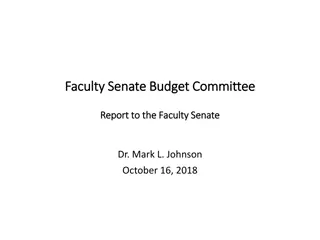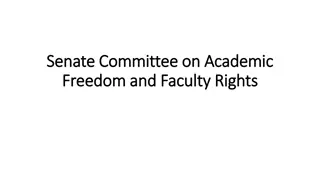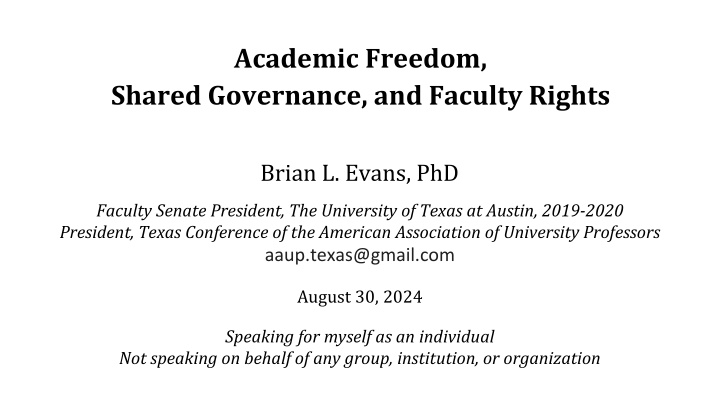
Academic Freedom, Shared Governance, and Faculty Rights in Higher Education
Explore the principles of academic freedom, shared governance, and faculty rights advocated by organizations like the American Association of University Professors. Learn about the importance of freedom in scholarship, research, and expression, as well as upcoming events in the Texas higher education community.
Download Presentation

Please find below an Image/Link to download the presentation.
The content on the website is provided AS IS for your information and personal use only. It may not be sold, licensed, or shared on other websites without obtaining consent from the author. If you encounter any issues during the download, it is possible that the publisher has removed the file from their server.
You are allowed to download the files provided on this website for personal or commercial use, subject to the condition that they are used lawfully. All files are the property of their respective owners.
The content on the website is provided AS IS for your information and personal use only. It may not be sold, licensed, or shared on other websites without obtaining consent from the author.
E N D
Presentation Transcript
Academic Freedom, Shared Governance, and Faculty Rights Brian L. Evans, PhD Faculty Senate President, The University of Texas at Austin, 2019-2020 President, Texas Conference of the American Association of University Professors aaup.texas@gmail.com August 30, 2024 Speaking for myself as an individual Not speaking on behalf of any group, institution, or organization
American Association of University Professors Since 1915, AAUP has been a central organizing force in higher ed in its widely adopted principles on academic freedom and shared governance. aaup.org AAUP has 42,000 members and 500 campus chapters championing these principles. Lamar University AAUP Chapter Pres. Pat Heintzelman Launched in January 2024 Brings together a network of scholars Provides mentoring and professional development Advocates on campus and beyond
American Association of University Professors AAUP affiliated with American Federation of Teaches (AFT) in August 2022: 1.8M members including 300,000 in higher education Texas AAUP Conference Formed in 1964 and affiliated with Texas AFT in March 2024 Provides professional development for a network of scholars Mobilizes members on 75, and chapters on 28, campuses Helps faculty navigate policies, investigations, and grievances Advocates at the Texas Legislature Upcoming Events Sept. 14, 2024, Texas Higher Education Summit, Beaumont, Texas, Elegante Hotel, 9am-6pm, Free registration. RSVP Pat Heintzelman. Sept. 28, 2024, Texas AAUP-AFT Fall Meeting, 9am-1pm. Zoom. RSVP Brian Evans.
1940 Joint AAUP/AAC&U Statement of Principles on Academic Freedom & Tenure (2600 words) Jointly formulated by Faculty (AAUP) and Presidents (AAC&U) American Association Colleges & Universities (AAC&U): 860+ institutions Principles adopted by all seven public university systems in Texas Academic Freedom for teachers consists of interrelated elements freedom to explore all avenues of scholarship, research, and creative expression and to publish the results of such work freedom to discuss all relevant matters in the classroom freedom from institutional censorship or discipline when speaking or writing as participants in the governance of an educational institution freedom from institutional censorship when speaking or writing as a citizen Free inquiry, free expression, and open dissent are critical for student learning and the advancement of knowledge here citizen means a member of society 1940 Statement: https://www.aaup.org/report/1940-statement-principles-academic-freedom-and-tenure
1940 Joint AAUP/AAC&U Statement of Principles on Academic Freedom & Tenure Academic freedom empowers teachers to bring the latest breakthroughs into the classroom innovate in scholarly research and creative endeavors develop and disseminate new knowledge from all viewpoints, including conservative, moderate, liberal, and apolitical (viewpoint diversity) help students develop the critical thinking, knowledge, training, and professional networks for successful careers Safeguards include tenure, due process, and shared governance Critical thinking is a required course outcome by THECB. [1] Required for university accreditation [2, p. 54] The institution publishes and implements appropriate policies and procedures for preserving and protecting academic freedom [1] Texas Higher Ed. Coordinating Board, Lower Division Academic Course Guide Manual, Spring 2018. [2] SACSCOC Resource Manual for the Principles of Accreditation: Foundations for Quality Enhancement, Feb. 2024
Texas State University System Rules and Regulations 4.7 Rights and Responsibilities as a Teacher and as a Citizen 4.7.1. Classroom. The faculty member is entitled to freedom in the classroom in discussing the faculty member s subject but should be judicious in the use of controversial material in the classroom and should introduce such material only as it has clear relationship to the subject field. 4.7.2. Research and Publication. The faculty member is entitled to freedom in research and in the publication of the results in accordance with responsible academic and professional practices. 4.7.3. Speaking as a Citizen. The faculty member is a citizen, a member of a learned profession, and an employee of an educational component supported by the State. When the faculty member speaks or writes as a citizen, the faculty member should be free from component censorship or discipline; but, the faculty member s special position in the community imposes special obligations. As a person of learning and a faculty member of a state funded educational component, the faculty member should remember that the public may judge his or her profession and component by his or her utterance. Hence, the faculty member should at all times be accurate, exercise appropriate restraint, and should show respect for the opinions of others . Restatement of the 1940 AAUP/AAC&U Statement on Principles of Academic Freedom and Tenure https://gato-docs.its.txst.edu/jcr:fe4852f4-5dfe-4e6a-837d-750ac9621db9/TSUS_Rules_and_Regs_thru_02-07-19.pdf
Faculty Shared Governance Has power to make the campus a better place to learn, work, and play for students, staff, faculty, and administrators Help improve learning & growth opportunities for all on campus Build better climate, relationships, and communities Foster better communication, hear out disagreements, and resolve conflicts Help provide safe & supportive environments for all on campus Health care, food security, and safety Academic support and professional development Example: Fall 2019. UT Austin Counseling & Mental Health Center.
1966 Joint Statement on Government of Colleges and Universities (3500 words) Jointly formulated by Faculty (AAUP), Presidents (ACE) and Trustees (AGB) American Council on Education (ACE): 1500+ institutions including Lamar University and the Texas State University System (TSUS) Assoc. of Gov. Boards of Universities and Colleges: 1300+ members including TSUS Faculty have primary decision-making authority in Curriculum, subject matter, and methods of instruction Those aspects of student life which relate to educational process Matters related to faculty status appointments, reappointments, decisions not to reappoint, promotions, granting of tenure, and dismissal President should exercise adversely only in exceptional circumstances, and for reasons communicated to the faculty & receive faculty feedback Faculty have authority in financial exigency and program closures 1966 Joint Statement, https://www.aaup.org/report/statement-government-colleges-and-universities
1966 Joint AAUP/ACE/AGB Statement on Government of Colleges and Universities President shares responsibility in Definition and attainment of goals Administrative action Communications to link components of academic community President provides institutional leadership Innovate, initiate, and persuade others to work toward goals Utilize judgments of the faculty and outside competent scholars Ensure standards and procedures conform to policy established by the board and standards of sound academic practice Manage and create resources President represents institution to public 1966 Joint Statement, https://www.aaup.org/report/statement-government-colleges-and-universities
1966 Joint AAUP/ACE/AGB Statement on Government of Colleges and Universities Maintains a general overview of the institution Entrusts conduct of administration to administrative officers Entrusts conduct of teaching and research to the faculty Publishes codified statements defining policies and procedures Provides long-term resource planning and oversees endowment Obtains capital and operating funds Supports institution when ignorance or ill will threatens any part In grave crises it will be expected to serve as a champion. Governing Board Roles SACS: "governing board protects the institution from undue influence by external persons or bodies. [2, p. 29] [1] 1966 Joint Statement, https://www.aaup.org/report/statement-government-colleges-and-universities [2] SACSCOC Resource Manual for the Principles of Accreditation: Foundations for Quality Enhancement, Feb. 2024
2016 UT System Faculty Advisory Council Shared Governance White Paper 1. An institution-wide commitment to the concept of shared governance linking the president, faculty, and all stakeholders in a well-functioning partnership, purposefully devoted to a clearly defined and broadly affirmed institutional vision. 2. An organizational culture of caring, mutual respect, and trust. 3. Consistently open, bidirectional, and transparent communication without threat or fear of reprisal. 4. A standing elected faculty governance organization recognized institution-wide as the voice of the faculty. 5. Partnership, shared responsibility, and shared accountability in decision-making for all academic, clinical, and research matters . 6. A proclivity for action and persistent follow-up on all institutional decisions. 2016 UT SysFAC Statement, https://wikis.utexas.edu/download/attachments/141739715/FINAL%20version%20UTS%20FAC%20White%20Pap er%20on%20Shared%20Governance_.pdf
Faculty Shared Governance Has power to make the campus a better place to learn, work, and play for students, staff, faculty, and administrators Help improve learning & growth opportunities for all on campus Build better climate, relationships, and communities Foster better communication, hear out disagreements, and resolve conflicts Help provide safe & supportive environments for all on campus Health care, food security, and safety Academic support and professional development In departments, colleges, and university-wide
Faculty Senate Membership Faculty Senators elected by the faculty Faculty Senators represent faculty to the administration Deans, VPs, Provost, and President as ex-officio members Who is invited to Faculty Senate meetings? How to include student and staff voices? Faculty Senators represent academic units What about faculty senators to represent tenured faculty? Non-tenured faculty?
Faculty Senate Resources @ UT Austin Staff Support 2 full-time administrative staff 1 half-time IT staff - elections, meetings, staff support, web pages, etc. Support for Officers President - 50% time administrative appointment. Reduction in teaching load of two courses. $15K discretionary funding for summer support or other uses. Secretary - Same as President. President-Elect - 25% time administrative appointment. Reduction in teaching load of one course. Past President - same as President-Elect
Example Faculty Senate Standing Committees Academic Freedom Faculty Grievance Faculty Workload and Compensation ** Academic Calendars ** Educational Policy ** Research Policy ** University Budgets ** ** Include administrators whose portfolios are aligned with committee as ex-officio members-- this will help ideas be implemented. Include student/staff government reps.
Example Joint Faculty Senate Provost Task Forces Faculty grievance policy revision COVID grading policies (Mar. 13-26, 2020) Academic calendar modification Course evaluation survey redesign Financial exigency policy (2015-2020) Non-tenure-track faculty Examples @ UT Austin Natural to draw faculty members from relevant standing committee members and Faculty Senate Executive Committee
Auxiliary Orgs to Help Faculty Senate AAUP members on campus Gives training on AAUP principles of academic freedom and shared governance Works with Faculty Senate to influence changes to campus policies Encourages members to run for Faculty Senate UT System Faculty Advisory Council association of Faculty Senates of all UT campuses Texas Council of Faculty Senates association of Faculty Senates of all 38 public universities
Peer Teaching Dialogues Helps inform a holistic view of teaching Formative peer teaching dialogue (see next slide) Opportunity to examine and modify one s teaching Based on shared understanding of good teaching Ongoing process can help trajectory over time Summative review of teaching Used in merit, promotion, tenure, and post-tenure reviews Based on course instructor survey scores and comments, formative peer teaching dialogues, faculty s statement, etc.
Peer Teaching Dialogues Examine course materials Discuss class expectations & content Pre- Observation Observe teaching content & style View student participation & learning Observation Discuss impressions of materials Discuss classroom observations Post- Observation Instructor analyzes teaching Instructor reflects on student learning Reflective Summary https://ctl.utexas.edu/peer-observation
1940 Joint AAUP/AAC&U Statement of Principles on Academic Freedom & Tenure Tenure provides the conditions for faculty to pursue research and innovation and draw evidence-based conclusions free from corporate or political pressure Tenure is an indefinite appointment terminated only for cause or extraordinary circumstances such as financial exigency All full-time faculty members, regardless of rank, are to be considered eligible for tenure 1940 Statement: https://www.aaup.org/report/1940-statement-principles-academic-freedom-and-tenure


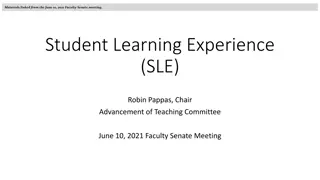

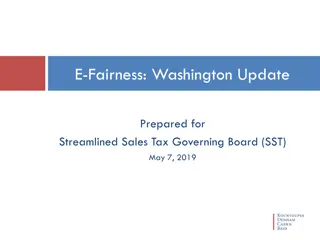
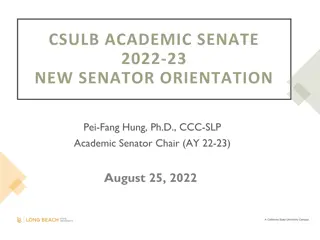
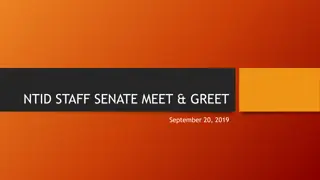
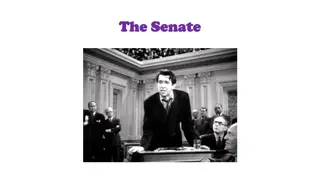
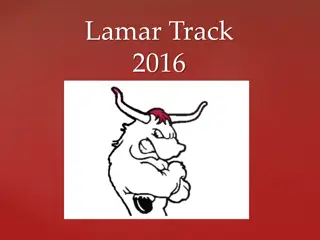
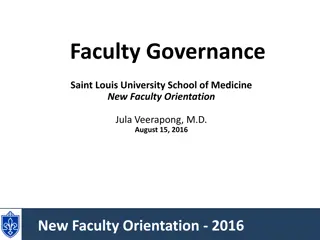


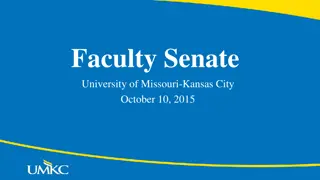
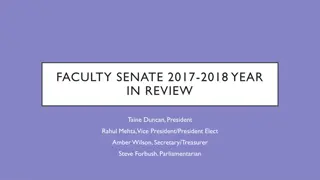
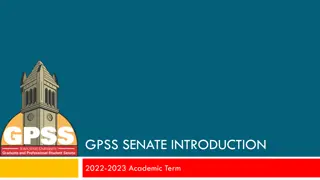
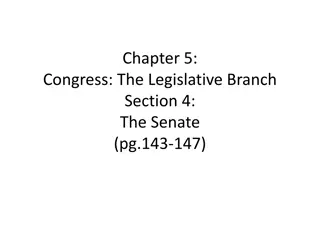
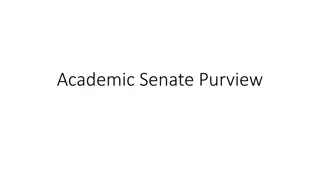

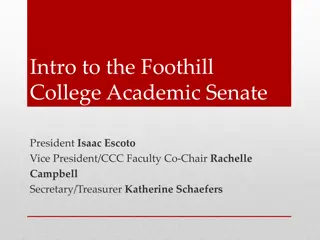
![Overview of the Faculty Senate at [Institution Name]](/thumb/233771/overview-of-the-faculty-senate-at-institution-name.jpg)
